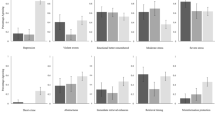Abstract
Despite great advances in pathophysiological facets of migraine that have been made during recent years, as of today, migraine etiology is still not completely understood; moreover, to date the relationship between psychological factors and this primary headache must be further elucidated. However, abnormal information processing, as measured by evoked and event-related potentials, has been considered a key feature in migraine pathogenesis. The aim of this work was to study the relationships between analytic/global style of information processing and migraine, hypothesizing an analytic style, as highlighted by our previous study on cluster headache. This study applied three cognitive style tests never previously used in the context of migraine: “Sternberg–Wagner Self-Assessment Inventory”, the C. Cornoldi test series called AMOS, and Brain-Dominance Questionnaire. 280 migraneurs with and without aura were tested and matched with two control groups: healthy subjects and tension-type headache patients. Our results demonstrated a strong correlation between analytic information processing style and migraine, indicating a preference toward a visual sensory approach in migraine without aura, in line with known neuroelectrophysiological data. These findings may suggest a role for this specific cognitive behavior in migraine pathogenesis, leading us to further investigate the neuroelectrophysiological, neurobiological, and epigenetic correlates.




Similar content being viewed by others
Abbreviations
- CH:
-
Cluster headache
- ICHD:
-
International Classification of Headache Disorders
- MA:
-
Migraine with aura
- MO:
-
Migraine without aura
- ETTH:
-
Episodic tension-type headache
- CTTH:
-
Chronic tension-type headache
- TTH:
-
Tension-type headache
- TSI:
-
Thinking Style Inventory
- QSC:
-
Cognitive Style Questionnaire
References
Siniatchkin M, Kropp P, Gerber W-B (2003) What kind of habituation is impaired in migraine patients? Cephalalgia 23(7):511–518
Shoenen J, Ambrosini A, Sandor PS, Maertens de Noordhout A (2003) Evoked potentials and transcranial magnetic stimulation in migraine: published data and viewpoint on their pathophysiologic significance. Clin Neurophysiol 114:955–972
Ambrosini A, Schoenen J (2006) Electrophysiological response patterns of primary sensory cortices in migraine. J Headache Pain 7:377–388
Waldie KE, Hansmann M, Milne BJ, Poulton R (2002) Migraine and cognitive function, a life, course study. Neurology 59:904–908
Coppola G, Pierelli F, Schoenen J (2009) Habituation and migraine. Neurobiol Learn Mem 92:249–259
Rankin CH, Abrams T, Barry RJ, Bhatnagar S, Clayton DF, Colombo J et al (2009) Habituation revisited: an updated and revised description of the behavioral characteristic of habituation. Neurobiol Learn Mem 92(2):135–138
Siniatchkin M, Kropp P, Neumann M, Gerber W-D, Stephani U (2000) Intensity dependence of auditory evoked cortical potentials in migraine families. Pain 85(1–2):247–254
Loder E (2002) What is the evolutionary advantage of migraine? Cephalalgia 22:624–632
Crisp AH, Levett G, Davies P, Rose FC, Coltheart M (1989) Cerebral hemisphere function and migraine. J Psychiatr Res 23(3–4):201–212
Goadsby PJ (2000) Headache. In: Warrel DA, Cox TM, Firth JD (eds) Oxford Textbook of medicine, 4th edn. Oxford Press, Oxford
Zenhausern R (1978) Imagery, cerebral dominance and style of thinking: a unified model. Bull Psychonomic Soc 12:381–384
Sternberg RJ (1997) Thinking styles. Cambridge University Press, Cambridge
Buonfiglio M, Di Sabato F (2011) Analytic cognitive style in cluster headache. Neurol Sci 32(5):875–881
Merckelbach H, Muris P, Pool K, De Jong PJ, Schouten E (1996) Reliability and validity of a paper and pencil test measuring hemisphere preference. Eur J Pers 10:221–231
Sperry R W (1981) Nobel Lecture: some effects of disconnecting the cerebral hemispheres. Nobel Lecture, Les Prix Nobel, Stockholm: Alm- quist & Wikesell; Nobelprize.org. http://www.nobelprize.org/nobel_prizes/medicine/laureates/1981/sperry-lecture_en.html. Accessed 13 Sep 2012
Springer SP, Deutsch G (1989) Left brain, Right brain. Freeman, New York
Riding RJ, Glass A, Butler SR, Playdeel-Pearce CW (1997) Cognitive style and individual differences in EEG, Alfa during information processing. Educ Psychol 17:219–234
Headache classification subcommittee of the international headache society (2004) The international classification of headache disorders. 2nd edn. Cephalalgia 24 [Suppl. 1]:1–160
De Beni R, Moĕ A, Cornoldi C (2003) Test Amos-Valutazione delle abilità di Studio-Stili cognitivi e motivazione. Centro Studi Erickson, Trento
Mariani L (1996) Brain dominance questionnaire (rev. edn.) Source questionnaire: revisions by E C Davis English Teaching Forum Vol. 32, No 3, 1994
Zhang LF (2000) Relationship between thinking style inventory and study process questionnaire. Pers Individ Differ 29(5):841–856
Aurora SK, Cao Y, Bowyer SM, Welch KMA (2002) The occipital cortex is hyper excitable in migraine: experimental evidence. Headache: J Head Face Pain 39(7):469–476
Mulleners WM, Chronicle EP, Palmer JE et al (2001) Visual cortex excitability in migraine with and without aura. Headache: J Head Face Pain 41(6):565–572
Chen Wei-Ta, Lin Yung-Yang, Fuh Jong Ling, Hämäläinen Matti S, Ko Yu-Chieh, Wang Shuu-Jiun (2011) Sustained visual cortex hyper excitability in migraine with persistent visual aura. Brain 134(8):2387–2395
Paemeleire K (2009) Brain lesions and cerebral functional impairment in migraine patients. J Neurol Sci 283(1–2):134–136
Buzzi MG, Cologno D, Formisano R (2005) Migraine disease: evolution and progression. J Headache Pain 6:304–306
Evers S, Quibeldey F, Grotemeyer K-H, Suhr B, Husstedt IW (1999) Dynamic changes of cognitive habituation and serotonin metabolism during the migraine interval. Cephalalgia 19(5):485–491
Sakai Y, Dobson C, Diksic M, Aube M, Hamel E (2008) Sumatriptan normalize the migraine attack-related increase in brain serotonin synthesis. Neurology 70:431–439
Schoenen J (1996) Deficient habituation of evoked cortical potentials in migraine: a link between brain biology, behavior and trigeminovascular activation? Biomed Farmacother 50:71–78
Stankewitr A, May A (2009) The phenomenon of changes in cortical excitability in migraine is not migraine-specific—a unifying thesis. Pain 145:14–17
Montagna P (2008) The primary headaches: genetics, epigenetics and a behavioral genetic model. J Headache Pain 9:57–69
Sacks O (1992) Migraine. V C Press, Berkeley
Jensen R (2001) Chronic tension type headache. Adv Stud Med 1(11):449–450
Acknowledgments
The authors wish to thank Raffaella Policastro, Valentina Retrosi and Kim Walther for their support in preparing the paper and are extremely grateful to Prof. Giuliano Avanzini for his precious advice and critical comments.
Conflict of interest
None.
Author information
Authors and Affiliations
Corresponding author
Rights and permissions
About this article
Cite this article
Di Sabato, F., Buonfiglio, M. & Mandillo, S. Analytic information processing style in migraineurs. Neurol Sci 34, 1145–1150 (2013). https://doi.org/10.1007/s10072-012-1193-8
Received:
Accepted:
Published:
Issue Date:
DOI: https://doi.org/10.1007/s10072-012-1193-8




